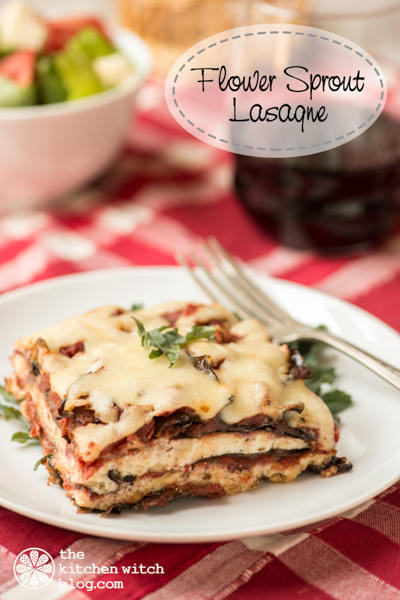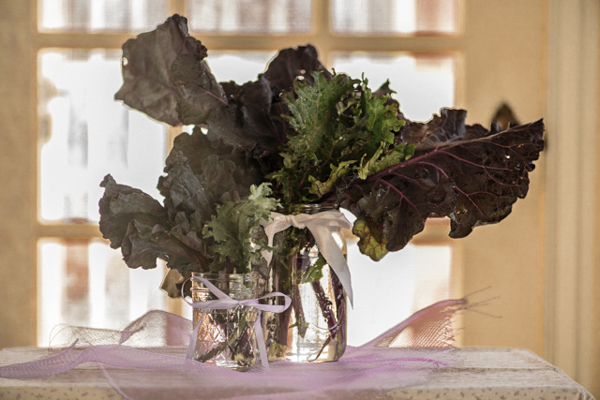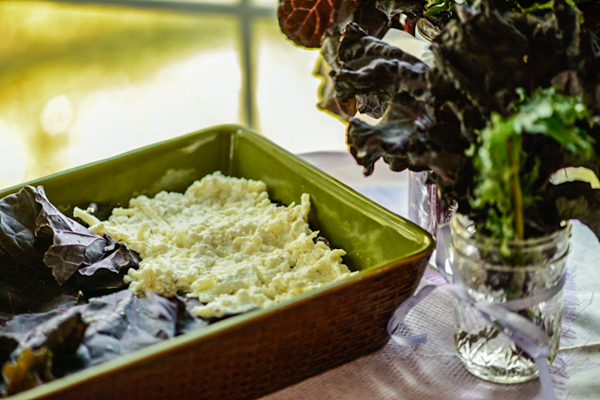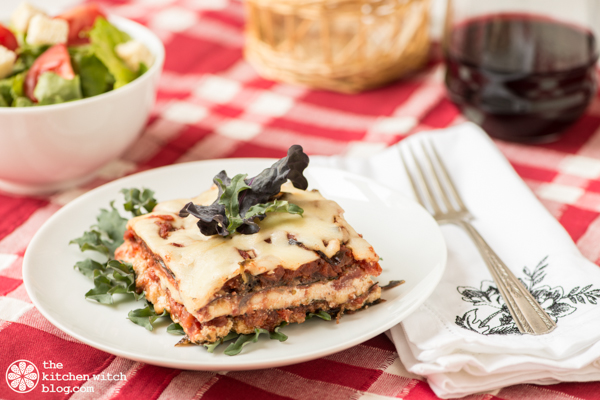Flower Sprout (Brassica oleracea), have you heard of it? I hadn’t heard of it until last month when a friend asked if I wanted some kale, she had pulled the last from her garden and had plenty to spare. Since my discovery/addiction of kale salt I was more than happy to take some off her hands. When I got to her house she asked if I was also interested in some flower sprout. I gave her this blank stare, flower sprout? I may not have decades of gardening under my belt but I do have decades of food knowledge and I had never ever heard of a flower sprout.
Before I accepted I needed to know what it was, it looked stunning, very beautiful and definitely had a kale like appearance. Like a true gardener she digs out her Johnny’s seed catalog, shows me the photo and lets me read the description. According to Johnny’s seed catalog:
“Flower Sprouts™ are a cross between Brussels sprouts and kale which, unlike Brussels sprouts, remain open and resemble attractive, colorful flowers. They grow on tall, upright plants just like Brussels sprouts. The tender, mildly flavored sprouts have an excellent eating quality and are suitable for sales to high-end restaurants and specialty markets. They are excellent lightly steamed or sautéed. One marketing suggestion is to sell them in clam shells. Not quite as hardy to cold weather as Brussels sprouts or kale.”
The flower sprout was invented in 2010 in Britain. It took 15 years of natural breeding technique to create this hybrid. Kale is great and Brussels sprouts are great so why do it, why combine them? Kale is a super food full of all things good for you; Brussels’s sprouts are tall and super producers. Mix a super producer with a super nutritious plant and you have a winner and evidently you end up with a 13 gallon garbage bags full of produce to share.
The younger leaves are tender and the older leaves are a bit tougher, more cabbage like. Like kale the small tender leaves can be eaten as is, but the older leaves are more palatable if they are cooked. Since it was definitely end of season, I got the bigger leaves. Actually I got an entire 13 gallon trash bag full of kale and flower sprout. That may seem like a lot however, when they are cooked crisp and crumbled to make salt a huge sack disintegrates into almost nothing.
I was quite pleased to see and taste flower sprout as another version of my ‘kale salt‘. Since the flower sprout I had was mostly a rich purple like cabbage, I mixed my flower sprout and kale ½ and ½ to make my kale/flower sprout salt. Naturally, I didn’t just make chips and salt from my bounty of flower sprouts, I also used some leaves as décor, they really are very lovely, it also found its way into soup and other dishes and of course this lasagna.
Because the leaves of the flower sprout were so large and hardy I thought that perhaps they might make a good substitute for pasta in lasagna. Turns out I was absolutely right! Not only were they hardy and tasty they added a beautiful colored layered. Although this wasn’t my goal, I did end up making beautiful gluten-free lasagna. The only error I made was not blanching the leaves first; they did release a fair amount of water in the cooking process (which was easily taken care of by pouring the liquid out mid-way through the cooking).
I kept the dish vegetarian, it seemed like the right thing to do to show case the flower sprout. I used a simple marinara and a combination of cheeses that got their flavor boosted with a little bit of oregano stirred into the mix. Like all lasagne’s this one was certainly better the next day, it is also one of the foods that photography better the next day also (unless you want to shoot it in the casserole hot and bubbling from the oven).
Here’s a link to a site dedicated entirely to the Flower Sprout, click here. To order the seed (now is the time to do it and if you live in Montana, flower sprout has a 110 day growing period, you’ll need to start these guys in March inside or in a greenhouse) you can get the seed from Johnny’s.
Lasagna or lasagne? How do you spell it? Until I became a blogger and the invention of spell correct I had always spelled lasagne with an ‘e’. I can remember (being phonetically taught), sounding it out in my head “la-sag-ne’. I’m a pretty decent speller (although horrible with grammar) and I never had reason to believe that lasagne was anything but lasagne, until, as I mentioned, life as a blogger. Bloggers have to be concerned with post titles, SEO traffic, etc. When something is titled incorrectly or not spelled correctly those little search crawler’s can’t find you.
So I conducted my own search, is it lasagna or lasagne and the answer I got was “yes”, as in both are totally correct. Lasagna with the ‘a’ is the singular version in Italian and it is the common spelling in the United States, the ‘e’ version is plural in Italian and is the common spelling in every country except the United States. Are the American’s right in this case? After all I only made one lasagna. Right or wrong, I live in the United States and it would be more proper for me to use the ‘a’ spelling and if I ever slip up and use the ‘e’ spelling, I’ll blame it on the 8 years I lived in Europe!
Are you a lasagna or lasagne person? How do you feel about new hybrid vegetables/food?


- 1 bunch, about 12 large leaves, Flower Sprout (or Kale), stemmed, blanched and drained
- 4 cups marinara sauce or meat sauce
- 2 cups cottage cheese
- 2 cups ricotta
- 1 cup grated Parmesan
- 4 cups grated mozzarella cheese, divided
- 1 tablespoon oregano
- Salt and Pepper to taste
- Preheat oven to 350°F.
- In a large mixing bowl, combine the cottage cheese, ricotta, Parmesan and 2 1/2 cups mozzarella cheese. Stir in oregano and salt and pepper.
- In a deep dish baking pan lightly coat the bottom of the pan with the marinara sauce, cover with one layer of flower sprout leaves. Top with 1/2 of the cheese mixture then the marinara sauce. Again layer the flower sprout leaves, cover with remaining cheese mixture and top with a little marinara. Finally finish with one more flower sprout layer and cover with remaining marinara.
- Cover with foil and bake for 45 minutes or until hot and bubbly. Remove foil and spread remaining mozzarella over the top, bake for an additional 15 minutes or until the cheese melts.
- Let the lasagna rest for a minimum of 20 minutes before slicing, for best results bake the day before, refrigerate and slice then heat the next day.






A great way to hide those veggies!
It is, my next door neighbor who hates cooked leafy veggies loved it!
What an awesome, delicious looking recipe. Thanks for sharing!
Trish
Have never heard of flower sprouts… great way to use them in this lasagna 🙂